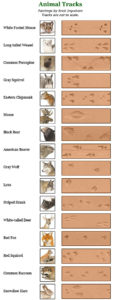 You don’t have to be in the jungle to be an animal tracker. Animal footprints are often as close as your backyard, garden or on one of the many Haliburton Highlands Hiking Trails.
You don’t have to be in the jungle to be an animal tracker. Animal footprints are often as close as your backyard, garden or on one of the many Haliburton Highlands Hiking Trails.
Take a look at these common animal track pictures—showing footprints in mud.
IDENTIFY ANIMAL TRACKS
Tracking is something that you learn by doing. Get out there and look! Here are a few tips:
- Animal tracks are easiest to find in mud, soft garden soil, sand, and snow.
- Study the ground closely. Get down on your hands and knees. Note the size of the track and whether it shows claw marks. You may wish to make a sketch.
- Track early in the morning or late in the day when shadows make prints easier to see.
- Watch for animal droppings called scat. The scat will also help you track the animal. If it’s dry all the way through, the tracks may have been left a while ago. Scat can also tell you if you’re tracking a vegetarian or a meat eater.
- If you lose the trail, search in a circle around the track until you pick up the trail again.
- The most important tip of all: don’t get lost!
For more information check out some of the links below;
https://www.backpacker.com/skills/how-to-recognize-and-identify-animal-tracks-on-the-trail
